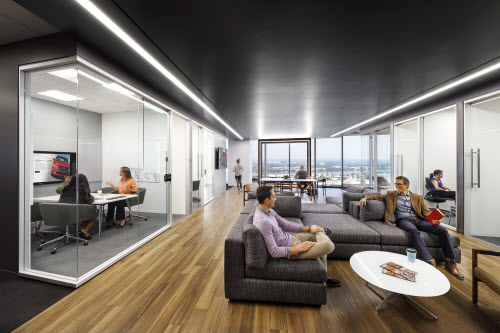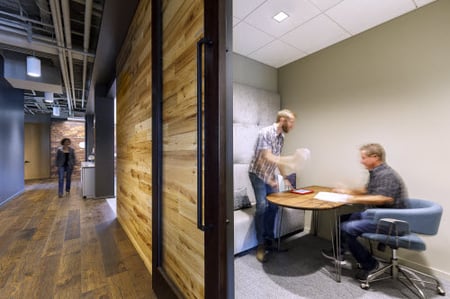Bringing Flexibility Back to Workplace Design
Chasing the latest trends can result in offices that don’t work for the employees.
 The hot new trend in workplace design is a willingness to avoid the hot new trend. The workplace environment of today should be about specificity, and not necessarily uniformity. Customized spaces tailored to the unique needs of the user rather than checking the box on the latest fad ensures a more effective solution.
The hot new trend in workplace design is a willingness to avoid the hot new trend. The workplace environment of today should be about specificity, and not necessarily uniformity. Customized spaces tailored to the unique needs of the user rather than checking the box on the latest fad ensures a more effective solution.
Far too often, corporate design follows a stale process driven by outside providers who are often more worried about a number goal or selling material than developing a smart design that works for the client. No office should be forced to adopt something seen as cutting edge, simply for the sake of appearing relevant.
A great example of this is open office design. In my opinion, open office design is somewhat dead as a universal solution. Employees want more—a solution that is creative and organic which suits their specific work habits. One size doesn’t fit all. Yet open office design is still promoted as a catch-all approach and that makes it hard for designers like us to say, “You know what? This might not be an appropriate response for your needs.
The better approach is to research and understand exactly who the employees are as well as their individual work processes, so that the space can be tailored for their specific needs. Flexibility is the forgotten element in today’s market. The process often doesn’t account for the ability to grow and change over time, to scale work environments based on market conditions. Who knows what the office will look like in five or 10 years?
Locking in to the latest trend might make an office obsolete in a few years. Trends come and go. If you look at pictures of typical corporate offices of the 1950s, you’ll see rows of desks that look suspiciously like modern open office designs. A few years back, traditional private offices practically disappeared from corporate office environments. But now we’re seeing a sort of resurgence, in response to the changing needs of users.
The next big thing in workplace design is going to be, in essence, a return to more traditional planning strategies. Hybrid spaces, which combine the very best of open office planning with the specificity of more traditional layouts, will have the ability to address more specific solutions to a user’s needs and processes. This type of planning leads to more flexible office environments that have more inherent potential to meet the needs of the individual employee. Companies usually have a mix of different types of workers and different work processes. Some departments need more specialized spaces; some don’t.
 The challenge is to maintain a budget-sensitive approach to growth, while still creating specific, adaptable spaces. For one client, we used a standardized workstation throughout the office which allowed for efficient, cost-effective planning. To address the more specific user needs, we integrated custom features within each workstation allowing for flexibility as well as varied work processes.
The challenge is to maintain a budget-sensitive approach to growth, while still creating specific, adaptable spaces. For one client, we used a standardized workstation throughout the office which allowed for efficient, cost-effective planning. To address the more specific user needs, we integrated custom features within each workstation allowing for flexibility as well as varied work processes.
Our process and our logic should be adaptable depending on the needs of the user. Basing an office environment on a blanket assumption of a certain square footage per person is being replaced by a more structured approach. Density allows for spaces to be designed with the unique needs of the specific end users of the space. Allowing for different types of solutions within a single workplace can allow square footage to be placed where it will be most beneficial.
I really love the process when we can get involved with the staff as early and as frequently as possible. That’s when we can deliver the most effective solution. In too many cases, organizations only allow us access to the executives or specific representatives. It’s not enough to take a survey or ask the managers. We need to listen more to the individual and be more responsive to their needs, understanding how they realistically use their space. This leads to more effective solutions that are tailored to need rather than trend.
One of my favorite things as a corporate designer is to be a fly on the wall for a few hours in a corporate environment, just to observe how people work first hand. Executives will often say the office is working great because they do not understand the inefficiencies within their own space.
But if we can sit and watch the way people are working, we can often create better, faster and smarter environments which can facilitate a more effective way in which to work. That is the true success of a tailored planning approach.
At every step, workplace interiors should be more research based and less trend based. Decisions should be the result of a more inclusive and collaborative approach that addresses specific needs rather than blanket planning concepts.
Design is not just about the way in which something looks and feels. It should also be about the way in which it functions. A beautiful watch is lovely to look at but if it doesn’t work its inherent value is diminished. The more specific the nature of our design and our design process can be, the more successful the final solution.
Rick D’Amato is the Director of Design for LPA’s workplace design group, based in Irvine, CA.
This story originally appeared in the latest edition of Catalyst, a quarterly publication that takes a deep dive into the new ideas, industry leaders and cutting-edge initiatives changing lives by design.